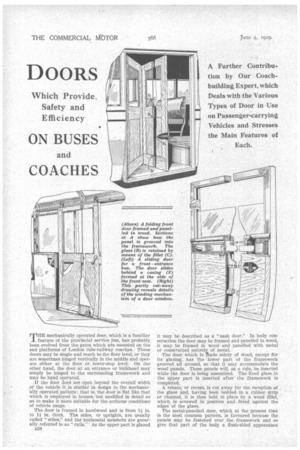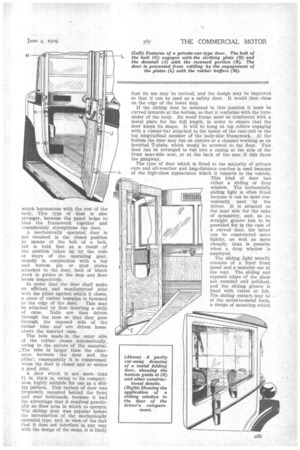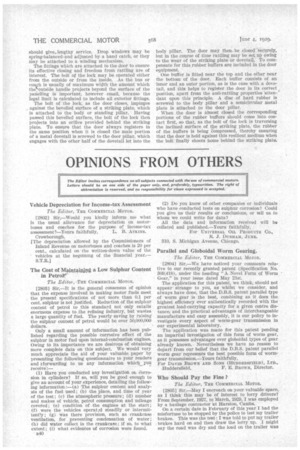DOORS
Page 64

Page 65

Page 66

If you've noticed an error in this article please click here to report it so we can fix it.
Which Provide Safety and Efficiency
ON BUSES
and
COACHES
THE mechanically operated door, which is a familiar feature of the provincial service pus, has probably been evolved from the gates which are mounted on the end platforms of London tube-railway coaches. These doors may be single and reach to the floor level, or they are Sometimes hinged vertically in the middle and operate either at the floor or lower-step level. On the other hand, the door at an entrance or bulkhead may simply be hinged to the surrounding framework and may be hand operated.
If the door does not open beyond the overall width of the vehicle It is similar in design to the mechanic'ally operated pattern ; that is, the door is flat like that which is employed in houses, but modified in detail so as to make it more suitable for the arduous conditions of vehicle usage.
The door is framed in hardwood and is from 1 in. to 1J1 in. thick. The sides, or uprights, are usually called "stiles," and the horizontal members are generally referred to as" rails." As the upper part is glazed B38 it may be described as a "sash door." In body construction the door may be framed and panelled in wood, it may be framed in wood and panelled with metal or constructed entirely of metal. • The door which is Made solely of wood, except for its glazing, has the lower part of the framework grooved all around, so that it may accommodate the wood panels. These panels will, as a rule, be inserted while the door is being assembled. The fixed glass in the upper part is inserted after the framework is completed.
A rebate, or recess, is cut away for the reception of the glass and, having been bedded in a rubber strip or channel, it is then held in place by a wood fillet, which is screwed in position and fitted against the edges of the glass.
The metal-panelled door, which at the present time Is the most ,common pattern, is favoured because the panels may be fastened over the, framework and so give that part of the body a flush-sided appearance
which harmonizes with the rest of the body. This type of -door is also stronger, because the panel helps to bind the framework together and considerably strengthens the door.
A mechanically operated door is not retained in the closed position by means of the bolt of a lock, but is held fast as a result of the position taken up by the rods or stays of the operating gear, usually in conjunction with a top and bottom pin or stud plates attached to the door, both of which work in guides at the step and floor levels respectively.
In order that the door shall make an efficient and weatherproof joint with the pillar against which it closes, a piece of rubber hosepipe is fastened to the edge of the door. This may be attached by, first inserting a strip of cane. Nails are then driven through the hose so that they pass through the exposed side of the rubber tube and are driven home above the inserted cane.
The hole made in the outer side of the rubber closes automatically, owing to the nature of the material. __The tube is larger than the clearance between the door and the pillar ; consequently it is compressed when the door is closed and so makes a good joint.
A door which is not more than 11 in. thick is, owing to its compactness, highly suitable for use as a sliding pattern. This variety of door was frequently mounted behind the front and rear bulkheads, because it had the advantage that it required practically no floor area in which to operate. The sliding door was popular before the introduction of the mechanically operated type, and, in view of the fact that it does not interfere in any way with the design of the steps, it is likely that its use may be revived, and the design may be improved -SO that it can be used as a safety door. It would then close on the edge of the lower step.
If the sliding door be mounted in this position it must be curved inwards at the bottom, so that it conforms with the turnunder of the body. Its wood frame must be reinforced with a metal plate for the full length, in order to ensure that the door keeps its shape. It will be hung on top rollers engaging with a runner-bar attached to the inside of the cant-rail or the top longitudinal member of the body-side framework. At the bottom the door may run on castors or a channel working on an inverted T-plate, which would be screwed to the floor. This door can be arranged to run into a casing at the side of the front near-side seat, or at the back of the seat if this faces the gangway.
The type of door which is fitted to the majority of private cars and all-weather and long-distance coaches is used because of the high-class appearance which it imparts to the vehicle. This kind of door has either a. sliding or drop window. The horizontally sliding light is often fitted because it can be most conveniently used by the driver. It is situated on the near side for the sake of symmetry, and, as no straight groove has to be provided for in the case of a curved door, the latter can be constructed more lightly, as well as more cheaply, than is possible when a drop window is employed. 1111111111(
The sliding light usually Consists of a fixed front panel and a movable one at the rear. The sliding and exposed edges of the glass are rounded and polished, and the sliding groove is lined with velvet or felt. The sliding contact may be of the metal-to-metal form, a design of mounting which
should give, lengthy service. Drop windows may be spring-balanced,and adjusted by a hand catch, or they may be attached to a winding mechanism.
The fittings which are attached to the door to ensure its effective closing and freedom from rattling are of interest. The bolt of the lock may be operated either from the outside or from the inside. As the bus or coach is usually of maximum width the amount which theCoutside handle projects beyond the surface of the panelling is important, however small, because the legal limit is calculated to include all exterior fittings.
The bolt of the lock, as the door closes, impinges against the bevelled surface of a striking plate, which is attached to the body or standing pillar. Having passed this bevelled surface, the bolt of the lock then projects into an orifice provided behind the striking plate. To ensure that the door always registers in the same position when it is closed the male portion of a metal dovetail is screwed to the door pillar, which engages with the other half of the dovetail let into the
body pillar. The door may then be closed 'securely, but in the course of time rattling may be set up Owing to the wear of the striking plate or dovetail. To compensate for this rubber buffers are included in the door etiuipment. One buffer is fitted near the top and the other near the bottom of the door. Each buffer consists of an inner and an outer portion, as is the case with a dovetail, and this helps to register the door in its correct position, apart from the anti-rattling properties'attendant upon this principle. A disc of hard rubber is screwed to the body pillar and a semicircular metal plate is attached to the door pillar.
When the door is almost closed the corresponding portions of the rubber buffers should come into contact first, so that, as the bolt of the lock is traversing the inclined surface of the striking plate, the rubber of the buffers is being compressed, thereby ensuring that the door is held against this resilient medium when the bolt finally shoots home behind the striking plate.




















































































































